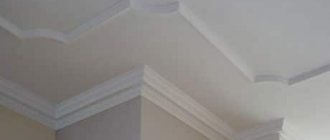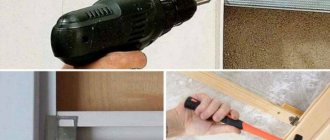Stretch ceilings » Stretch ceiling
Flood from above
Stretch ceiling structures are not just amazingly beautiful. They are also very practical. These products do not deteriorate when exposed to moisture, and if your upstairs neighbors flood you, then leaking water from under such ceilings can be easily removed. You just need to know how to drain water from a suspended ceiling and follow all the recommendations in the correct sequence.
After drying, the material will again take on its original shape, so neither your ceiling nor the furnishings of the room will be damaged at all.
How can you expect flooding in your home?
It would seem that reinforced concrete floor slabs should not allow any leaks. And yet, water always finds its way, seeping into your ceiling from the upper floors.
But the fact is that the slabs in multi-story buildings are attached to each other with special mounting grooves or using reinforcement joints. No matter how hard builders try, they cannot make the joints perfectly airtight.
However, this is a question of the quality of construction work in general, because some “workers” don’t even try very hard, filling the cracks with insulation. And this is even at best. It happens that they are simply filled with construction waste. This approach leads to the fact that water from above penetrates into our apartments almost unhindered.
Usually moisture begins to ooze along the perimeter of the room, but it can also appear in the center of the room, because cracks in slabs are also not uncommon. If you install a suspended ceiling in a room, water will accumulate in its fabric. Over time, the ideal geometry of the ceiling will begin to be disrupted, and it will slowly be pulled down.
Are all suspended ceilings equally resistant to flooding?
There is an opinion that any tension covering can reliably retain water. This statement is only half true. The fact is that the main importance here is the quality of materials. Some canvases, after draining the water, can take their previous shape without losing their appearance, while others must be replaced.
Features of fabric-based ceilings
Drying the ceiling
In the production of seamless fabric-based tension coverings, fabric is used that is impregnated with a special polyurethane composition. This substance serves as a waterproof layer for the material. But the effectiveness of such impregnation is very doubtful.
Of course, the fabric ceiling will hold back flooding for some time, but water will still begin to seep through the fibers of the material. Eventually you will need to replace the coating. Therefore, you should not take risks by installing such products in places where the risk of leakage is especially high, for example, in bathrooms or showers.
Features of polyvinyl chloride (PVC) stretch ceilings
PVC film construction is an excellent option if you need reliable protection against leaks. The name speaks for itself - film, which means that all the water will accumulate only inside the ceiling, without damaging anything in the room. Your task is to remove the accumulated liquid in a timely manner.
Important! One square meter of PVC film can withstand a 100-kilogram load from incoming water.
The completeness of restoration of the shape of the PVC coating will depend only on the volume of leaked water. Most often, this happens almost painlessly for a stretch ceiling, which, after drying, acquires its initially ideal evenness and beauty.
How to properly drain water from a suspended ceiling?
Home page » Useful
Well-known folk wisdom says that you usually don’t choose neighbors and friends. What to do in a situation where the neighbors living above flooded the room when all the water accumulated on the inside of the stretch ceiling. At first glance, it may seem to many that situations of this kind do not happen every day, so there is no need to think about it. Despite this, such a phenomenon as leaks that come from above can be characterized as a real flood. It is able to cause serious damage to interior items and furniture, equipment, as well as objects of art, which is even more important. Stretch ceilings are becoming popular, which not only provide an attractive appearance to the room, but are also able to absorb water without further leakage, thereby protecting all the objects that are in the apartment. On their inner surface they are able to hold quite a large amount of water.
Don’t let the sight of a huge drop disturb you; major repairs to the ceiling and the room itself will not be required. All you need to do is properly drain the accumulated water. You can do this by calling a specialist or doing it yourself, following the advice from this article.
The first option for draining water from a suspended ceiling
Decorative baguette
If you detect a certain deformation of the stretch ceiling, which slightly resembles a large drop, you should completely turn off the electricity and immediately, without delay, contact the company that installed such a ceiling and can drain the water accordingly. Employees of this organization usually respond to calls of this kind as quickly as possible, that is, the water will be drained very quickly. For this purpose, a special hose and holes are used where lighting devices are mounted. If accumulated water is drained from a stretch ceiling on which lighting has not been installed, at the beginning of all work a special decorative baguette will be removed, only then the canvas itself will be folded back. A special hose is inserted into the opening that appears, and then the water is drained.
Immediately after complete removal of water, the company’s professionals thoroughly dry the ceiling using a special construction hair dryer. Thanks to the hot air flow coming out of the hair dryer, it will not only get rid of moisture in the existing inter-ceiling space, but will completely restore its previous shape without any traces of stretching.
How to drain the water yourself
Construction hair dryer (needed for drying the ceiling)
If you cannot use the help of professionals, you can easily drain the water yourself. It is important to remember here that water can be removed, but returning the ceiling to its previous appearance may not be completely ideal. You can drain the water yourself through a certain sequence of steps:
- The electricity goes out completely;
- The process of water inflow is eliminated;
- The lamps are completely removable;
- The water is drained using a special hose inserted into the hole and collected in a previously prepared container;
- The canvas dries well and is fixed, if possible, in the same position.
It is strictly forbidden to pierce the ceiling, since violating its integrity will not protect against future floods.
To avoid all unforeseen situations, it is recommended to contact a professional company, which usually has drained more than one ton of water over the entire period of its activities. In addition, a large number of suspended ceilings have been restored to their former attractive appearance. Employees of such companies, before installing the canvas in place, not only wash the inner surface of the stretch ceiling, but also treat it with a special composition that will protect against the formation of destructive mold and mildew. According to professionals, even if it is possible to completely remove the water, dry it correctly and according to all the rules, it is advisable to cover the inside with a protective layer against fungus.
It is also mandatory to use high-quality modern equipment and tools for a good result.
remontikvannoj.ru
How to properly remove water from a stretch ceiling - several proven methods
Draining water through the chandelier hole
Moisture entering the room gradually stretches the film. A noticeable bubble forms in this area of the structure. Let's look at how to drain water from a stretch ceiling, especially since its structure makes it quite easy to do this using two simple methods.
Important! Before starting manipulations with the ceiling structure, be sure to turn off the electricity! Otherwise, you risk putting your health at great risk. In addition, all household appliances should be removed from the premises.
First way to remove water
Water can be drained through the holes designed for installing recessed ceiling lights or chandeliers. To do this you need:
- Remove the lighting fixture, under which you will see a polyvinyl chloride ring and a small entrance intended for installing a lamp.
- Gently pull back the mounting ring, lift the water bubble and move it towards the hole. Then drain the water into a previously prepared container. To carry out such an operation, the participation of two people will be required.
Second way to remove water
Connecting the hose to the chandelier hole
The liquid can be drained in one of the areas around the perimeter of the room. Do it like this:
- Remove the plinth and detach the film of the stretch ceiling covering in this place.
- Carefully moving the resulting accumulation of water towards the edge of the canvas, drain it into any suitable container and install the elements of the tension structure in place.
After completing the procedure, to give the film its original shape, dry it with a regular hairdryer. This is a rather painstaking process, but if you want to perfectly restore the ceiling, do the work very carefully.
Attention! Do not forget that when removing moisture after flooding, under no circumstances should you pierce or cut the coating! After such an operation, the material will be hopelessly damaged.
Water in a suspended ceiling and 3 steps to eliminate it
Photo of a water bubble formed in the polyvinyl chloride fabric of a stretch ceiling
If there is water in a suspended ceiling, then it needs to be removed from there - an elementary truth that does not require confirmation. No one wants to share a room with a huge water bubble hanging over their head. And I’ll tell you how to do it correctly in this article.
We approach the task competently
Let’s simulate the situation: you have finally become the happy owner of suspended ceilings and one “beautiful” day, when you came home, you discovered a huge cocoon hanging down. There is no need to be scared and call ufologists; this ceiling structure should still work in case of flooding of the apartment by upper neighbors. But this situation cannot be ignored either.
Previously, this could only be seen in science fiction films, and it did not bode well for the heroes
The instructions for the necessary actions consist of 3 main steps:
Step No. 1: localize the emergency situation
If the suspended ceiling is sagging due to water, then the first thing to do is this:
- Turn off the electricity in the apartment. Between the polyvinyl chloride sheet and the concrete ceiling base there is electrical wiring leading to the lighting fixtures. Such proximity to accumulated liquid can lead to tragic consequences, including electric shock to residents, including you;
In the suspended ceiling, the water was dangerously close to the chandelier, therefore, an urgent shutdown of the electric meter is required
- Then go to your neighbors to:
- Determine the source of the flooding, which will also affect the approach to eliminating liquid from the resulting bubble. Here the following options may be observed:
| Type of accident | Comments |
| Cold water pipeline rupture | The simplest case, when eliminating the consequences of which you can simply follow further instructions without any additions |
| Hot water pipeline rupture | There is a danger of burns, but at the same time, the PVC sheet can also become deformed from high temperatures as a result of prolonged inactivity, so you will have to take a risk and eliminate the problem yourself |
| Heating system rupture | The danger is even higher than in the situation described above, both in relation to you and in relation to the ceiling itself, the price of which, as you well know, is considerable |
| The appearance of a leak in the sewer system | The most unpleasant situation, since “fighting” with feces is incredibly disgusting, here, perhaps, it is better to pass the baton to specialists |
| Storm drain breakdown | Rainwater cannot be hot, and although it is dirtier than that supplied through the water supply system, the situation can still be considered similar |
| Washing machine breakdown | Here the liquid does not contain human waste products and, as a rule, has a non-hazardous temperature |
A break in the water supply system is the most common reason for water leaking from the ceiling.
If the appearance of a PVC bubble is associated with a breakdown of the sewer or heating system of your upper neighbors, then be sure to stock up on rubber gloves, safety glasses and a respirator before you begin removing it. Such ammunition will allow you to more easily and painlessly endure a collision with sewage and boiling water.
Problems with the sewerage of the upper neighbors are the worst thing that can await your suspended ceiling
- Make sure that all risers related to the emergency are closed and work is underway to eliminate the problem. If this does not happen, then insist on active action and contact the appropriate services. What's the point of removing water from the bladder if it continues to flow in?
A simple turn of the desired tap to the closed position will stop the accumulation of liquid in your stretch ceiling
Step No. 2: call specialists
Although you can pump out the water yourself, in any case, a team of installers with a heat gun will have to return the PVC ceiling to its original beautiful appearance. Therefore, I highlight this action as a separate paragraph to emphasize its importance. After you return from your neighbors, call the technical service.
Specialists have the necessary equipment that will allow you to restore the beauty of your stretch ceiling after all the misadventures
Step #3: remove liquid
It’s great if the problem happened in broad daylight, when all service centers are open and can send a repair team to you in a timely manner. But more often the situation is somewhat different: you return from work late at night and discover a swollen cocoon when the repairmen have also definitely arrived at their families.
And what to do in this case? First of all, don't despair.
A bubble discovered late in the evening will have to be eliminated on its own.
So let's look at how to remove water from a stretch ceiling yourself:
- Remove all valuables from the emergency room and cover the furniture with plastic wrap. With the right approach to eliminating liquid, a flood should not occur, but it is better to play it safe and protect your property as much as possible;
Before draining water from a suspended ceiling, cover the furniture with moisture-proof film
- How many liters of water can a polyvinyl chloride stretch ceiling hold? About one hundred kilograms per square meter. This means that a lot of liquid may already have accumulated in the bubble, so stock up on the following supplies:
| Name | Purpose |
| Buckets or other suitable containers with a volume of at least eight liters | Collecting the contents of the PVC cocoon |
| Hose at least two meters long | Transporting the contents of a PVC cocoon in containers |
A hose and a set of suitable containers are mandatory equipment for downloading water from the formed bubble.
I also recommend getting at least one assistant. After all, when you stand under the canvas with a hose at arm's length, someone will need to change the filling buckets.
There can be a lot of filled buckets
- Now we determine the drain point, in the role of which we can use either the nearest hole for the lighting fixture, or the nearest edge of the polyvinyl chloride sheet tucked into a baguette:
Ideal places to drain fluid accumulated in the bladder
- In the first case, we check again whether the electricity is turned off, and then unscrew the lamp or chandelier. Then we insert one of the edges of the hose into the vacated hole;
This is what it looks like when pumping water out of a suspended ceiling through a hole created by installers for a lighting fixture.
Never try to make a hole yourself using a knife or other piercing or cutting objects. With such tension, the cocoon will simply burst and the entire room, along with you, will end up in its contents. Well, the ceiling itself cannot be restored.
- In the second, carefully remove the edge of the canvas from the fillet using a spatula and also insert a hose into the gap that appears;
Using the edge of the canvas to penetrate the “heart” of the stretch ceiling
Do not try to disperse the water with your hands. This will lead to its spread over the entire plane of the ceiling structure and make it difficult to eliminate. As a result, some of the moisture may remain there even after the repair crew has left, where it will eventually cause mold to grow.
- Next, lower the free end of the hose into an empty container;
- Carefully pull the bubble towards the hole so that its contents go into the hose on their own and begin to flow through it into the bucket;
- As the container is filled, we clamp the hose with our hand, and in the meantime, our partner changes the container. If you act on your own, then you need to act much more carefully, and after the bucket is filled, pull out the hose altogether to exclude the possibility of further supply of liquid;
Self-removal of water from the bladder forces you to adapt to the inconvenience
- We continue this way until the bubble “deflates”, after which we wait for a team with a heat gun to return your stretch ceiling to its previous appearance.
Stretch ceiling freed from liquid
You can do without a hose, but then the process will be much less convenient, and some of the water will probably spread throughout the room. Still, a two-meter PVC pipe is not such an expensive “pleasure” that you have to give it up, thereby dooming yourself to an unplanned shower from a suspended ceiling.
Removing fluid without using a hose is less convenient, but also possible
Conclusion
From the article you learned how to pour water out of a stretch ceiling. A bucket, a hose, a faithful companion and peace of mind are all you need to successfully complete the task. The video in this article contains materials that complement the information presented. However, please ask any questions you have in the comments.
First of all, calmness, and then solving the problem
Subscribe to our channel in Telegram
obustroeno.com
Summary
Of course, the easiest way out in this situation is to call a specialist at home. He will drain the water, and then, using a heat gun, restore the ideal surface of the tension covering.
If you are not confident in your abilities and are not ready to take on all the risks associated with damage to the suspended ceiling and the property of the room, invite a professional craftsman. Or do it just for the first time. And then, after watching all the technology for performing the process “live”, which, by the way, can be done using video, you will not be afraid to take on the task of removing water from the stretch ceiling yourself. Moreover, now you are familiar with all the most important nuances of this unpleasant process, from which, by the way, no one is immune.
Related Posts
- Do-it-yourself analysis of modern ceiling finishing technologies
- We figure out how to paint the ceiling correctly
- How to choose material for suspended ceilings
- What types of tension fabrics are there - an overview of the modern market
19.09.2013











